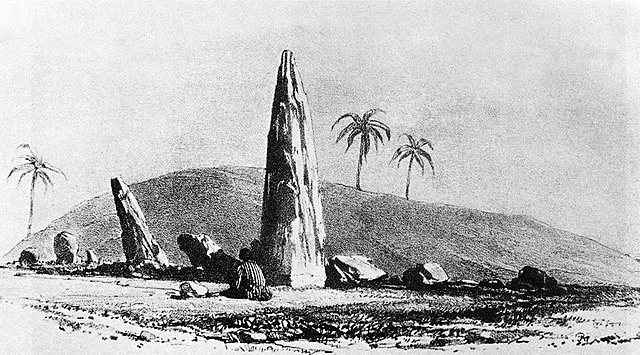The Cromlech de Mzoura, also known as the Mzoura Stone Circle, is a prehistoric monument located in northern Morocco, about 15 kilometers southeast of Asilah. This site stands as one of the most significant examples of megalithic architecture in North Africa, showcasing the region’s early human activity.
Get your dose of History via Email
Structure and Composition
The Cromlech de Mzoura is a circular arrangement of over 170 standing stones, also known as menhirs. These stones form a perimeter around a large tumulus, or burial mound, which is approximately 55 meters in diameter. The tallest stone, at about 5 meters high, is positioned prominently on the site’s eastern side. The circle is slightly elliptical in shape, with a noticeable elongation along its north-south axis.
Historical Context
Dating the construction of the Cromlech de Mzoura has proven difficult due to the lack of associated archaeological materials. However, scholars generally attribute the monument to the Neolithic or early Bronze Age, likely between 2500 and 1500 BC. The site’s purpose remains uncertain, but its form is similar to other stone circles found in Europe, particularly in Iberia and Brittany, suggesting potential cultural links between North Africa and these regions.
Theories Regarding Its Function
The exact function of the Cromlech de Mzoura is still debated. Some archaeologists believe it served as a ceremonial or religious site, while others suggest it could have been a burial or commemorative structure. The large tumulus at the center indicates a possible connection to burial practices, but the lack of extensive excavations makes it difficult to confirm.
There is also speculation that the site had astronomical significance, similar to other megalithic monuments worldwide. The positioning of the stones could have aligned with celestial events, although this theory remains unproven.
Archaeological Excavations
Very few archaeological excavations have taken place at the Cromlech de Mzoura, limiting our understanding of its history. French archaeologists first documented the site in the early 20th century. However, more recent studies have been sporadic. Excavations in the 1930s uncovered pottery fragments and other small artifacts, but none were sufficient to provide precise dating or further insight into the site’s function.
Connections to Local Myths
The Cromlech de Mzoura has also been linked to local myths and legends. Some historians connect the site to the ancient Berber kings, particularly the mythical figure of Antaeus, who was believed to be buried in the area. According to Greek mythology, Antaeus was a giant and the son of Poseidon and Gaia. His tomb, as described in classical sources, is sometimes associated with the large tumulus at the center of the Cromlech.
Importance in North African Archaeology
The Cromlech de Mzoura remains a vital site for understanding the prehistory of North Africa. Its scale and similarity to European megalithic structures suggest that ancient Morocco had connections to broader cultural networks. Additionally, the monument provides valuable insight into early human societies in the region, especially regarding their burial and ceremonial practices.
Preservation and Tourism
Despite its importance, the Cromlech de Mzoura is not as well-known as other megalithic sites worldwide. Preservation efforts have been limited, and the site does not receive significant tourist attention. However, increasing interest in Morocco’s ancient heritage may lead to more detailed research and conservation in the future.
Conclusion
The Cromlech de Mzoura is one of Morocco’s most intriguing prehistoric monuments. Its complex stone circle, the mysterious central tumulus, and the limited archaeological research make it a key site for understanding ancient North African societies. As further studies and excavations take place, new insights will likely emerge regarding its role in regional prehistory.
Source:

